Configurational Effects on Strain and Doping at Graphene-Silver Nanowire Interfaces
Abstract
1. Introduction
2. Results and Discussion
3. Conclusions
4. Material and Methods
Author Contributions
Funding
Acknowledgments
Conflicts of Interest
References
- Bonaccorso, F.; Sun, Z.; Hasan, T.; Ferrari, A.C. Graphene photonics and optoelectronics. Nat. Photonics 2010, 4, 611. [Google Scholar] [CrossRef]
- Wang, Y.; Shi, Z.; Huang, Y.; Ma, Y.; Wang, C.; Chen, M.; Chen, Y. Supercapacitor Devices Based on Graphene Materials. J. Phys. Chem. C 2009, 113, 13103–13107. [Google Scholar] [CrossRef]
- Gong, T.; Zhang, J.; Zhu, Y.; Wang, X.; Zhang, X.; Zhang, J. Optical properties and surface-enhanced Raman scattering of hybrid structures with Ag nanoparticles and graphene. Carbon 2016, 102, 245–254. [Google Scholar] [CrossRef]
- Xu, G.; Liu, J.; Wang, Q.; Hui, R.; Chen, Z.; Maroni, V.A.; Wu, J. Graphene: Plasmonic Graphene Transparent Conductors (Adv. Mater. 10/2012). Adv. Mater. 2012, 24, OP70. [Google Scholar] [CrossRef]
- Li, X.; Li, J.; Zhou, X.; Ma, Y.; Zheng, Z.; Duan, X.; Qu, Y. Silver nanoparticles protected by monolayer graphene as a stabilized substrate for surface enhanced Raman spectroscopy. Carbon 2014, 66, 713–719. [Google Scholar] [CrossRef]
- Si, C.; Liu, Z.; Duan, W.; Liu, F. First-principles calculations on the effect of doping and biaxial tensile strain on electron-phonon coupling in graphene. Phys. Rev. Lett. 2013, 111, 196802. [Google Scholar] [CrossRef]
- Si, C.; Sun, Z.; Liu, F. Strain engineering of graphene: A review. Nanoscale 2016, 8, 3207–3217. [Google Scholar] [CrossRef]
- Mueller, N.S.; Heeg, S.; Alvarez, M.P.; Kusch, P.; Wasserroth, S.; Clark, N.; Schedin, F.; Parthenios, J.; Papagelis, K.; Galiotis, C. Evaluating arbitrary strain configurations and doping in graphene with Raman spectroscopy. 2D Materials 2017, 5, 015016. [Google Scholar] [CrossRef]
- Palermo, V.; Palma, M.; Tomović, Ž.; Watson, M.D.; Friedlein, R.; Müllen, K.; Samorì, P. Influence of Molecular Order on the Local Work Function of Nanographene Architectures: A Kelvin-Probe Force Microscopy Study. ChemPhysChem 2005, 6, 2371–2375. [Google Scholar] [CrossRef]
- Young, A.F.; Kim, P. Quantum interference and Klein tunnelling in graphene heterojunctions. Nat. Phys. 2009, 5, 222–226. [Google Scholar] [CrossRef]
- Abanin, D.A.; Levitov, L.S. Quantized transport in graphene pn junctions in a magnetic field. Science 2007, 317, 641–643. [Google Scholar] [CrossRef]
- Syed, S.R.; Lim, G.-H.; Flanders, S.J.; Taylor, A.B.; Lim, B.; Chon, J.W.M. Single layer graphene band hybridization with silver nanoplates: Interplay between doping and plasmonic enhancement. Appl. Phys. Lett. 2016, 109, 103103. [Google Scholar] [CrossRef]
- Wu, T.; Shen, H.; Sun, L.; Cheng, B.; Liu, B.; Shen, J. Facile synthesis of Ag interlayer doped graphene by chemical vapor deposition using polystyrene as solid carbon source. ACS Appl. Mater. Interfaces 2012, 4, 2041–2047. [Google Scholar] [CrossRef]
- Sun, H.-B.; Fu, C.; Xia, Y.-J.; Zhang, C.-W.; Du, J.-H.; Yang, W.-C.; Guo, P.-F.; Xu, J.-Q.; Wang, C.-L.; Jia, Y.-L. Enhanced Raman scattering of graphene by silver nanoparticles with different densities and locations. Mater. Res. Express 2017, 4, 025012. [Google Scholar] [CrossRef]
- Lee, J.E.; Ahn, G.; Shim, J.; Lee, Y.S.; Ryu, S. Optical separation of mechanical strain from charge doping in graphene. Nat. Commun. 2012, 3, 1024. [Google Scholar] [CrossRef]
- Ploss, R.S. Material Trivial Transfer Graphene. Google Patents No. US8906245B2, 19 December 2014. [Google Scholar]
- Lindahl, N.; Midtvedt, D.; Svensson, J.; Nerushev, O.A.; Lindvall, N.; Isacsson, A.; Campbell, E.E.B. Determination of the bending rigidity of graphene via electrostatic actuation of buckled membranes. Nano Lett. 2012, 12, 3526–3531. [Google Scholar] [CrossRef]
- Scharfenberg, S.; Mansukhani, N.; Chialvo, C.; Weaver, R.L.; Mason, N. Observation of a snap-through instability in graphene. Appl. Phys. Lett. 2012, 100, 021910. [Google Scholar] [CrossRef]
- Schlaf, R.; Murata, H.; Kafafi, Z.H. Work function measurements on indium tin oxide films. J. Electron Spectrosc. Relat. Phenom 2001, 120, 149–154. [Google Scholar] [CrossRef]
- Malard, L.M.; Pimenta, M.A.A.; Dresselhaus, G.; Dresselhaus, M.S. Raman spectroscopy in graphene. Phys. Rep. 2009, 473, 51–87. [Google Scholar] [CrossRef]
- Suzuki, S.; Yoshimura, M. Chemical stability of graphene coated silver substrates for surface-enhanced Raman scattering. Sci. Rep. 2017, 7, 14851. [Google Scholar] [CrossRef]
- Muntean, C.M.; Dina, N.E.; Coroş, M.; Toşa, N.; Turza, A.I.; Dan, M. Graphene/silver nanoparticles-based surface-enhanced Raman spectroscopy detection platforms: Application in the study of DNA molecules at low pH. J. Raman Spectrosc. 2019, 50, 1849–1860. [Google Scholar] [CrossRef]
- Ferrari, A.C.; Meyer, J.C.; Scardaci, V.; Casiraghi, C.; Lazzeri, M.; Mauri, F.; Piscanec, S.; Jiang, D.; Novoselov, K.S.; Roth, S. Raman spectrum of graphene and graphene layers. Phys. Rev. Lett. 2006, 97, 187401. [Google Scholar] [CrossRef]
- Jiang, T.; Wang, Z.; Ruan, X.; Zhu, Y. Equi-biaxial compressive strain in graphene: Grüneisen parameter and buckling ridges. 2D Materials 2018, 6, 015026. [Google Scholar] [CrossRef]
- Guo, C.; Zhang, J.; Xu, W.; Liu, K.; Yuan, X.; Qin, S.; Zhu, Z. Graphene-based perfect absorption structures in the visible to terahertz band and their optoelectronics applications. Nanomaterials 2018, 8, 1033. [Google Scholar] [CrossRef]
- Tan, X.; Wang, Z.; Yang, J.; Song, C.; Zhang, R.; Cui, Y. Polyvinylpyrrolidone-(PVP-) coated silver aggregates for high performance surface-enhanced Raman scattering in living cells. Nanotechnology 2009, 20, 445102. [Google Scholar] [CrossRef]
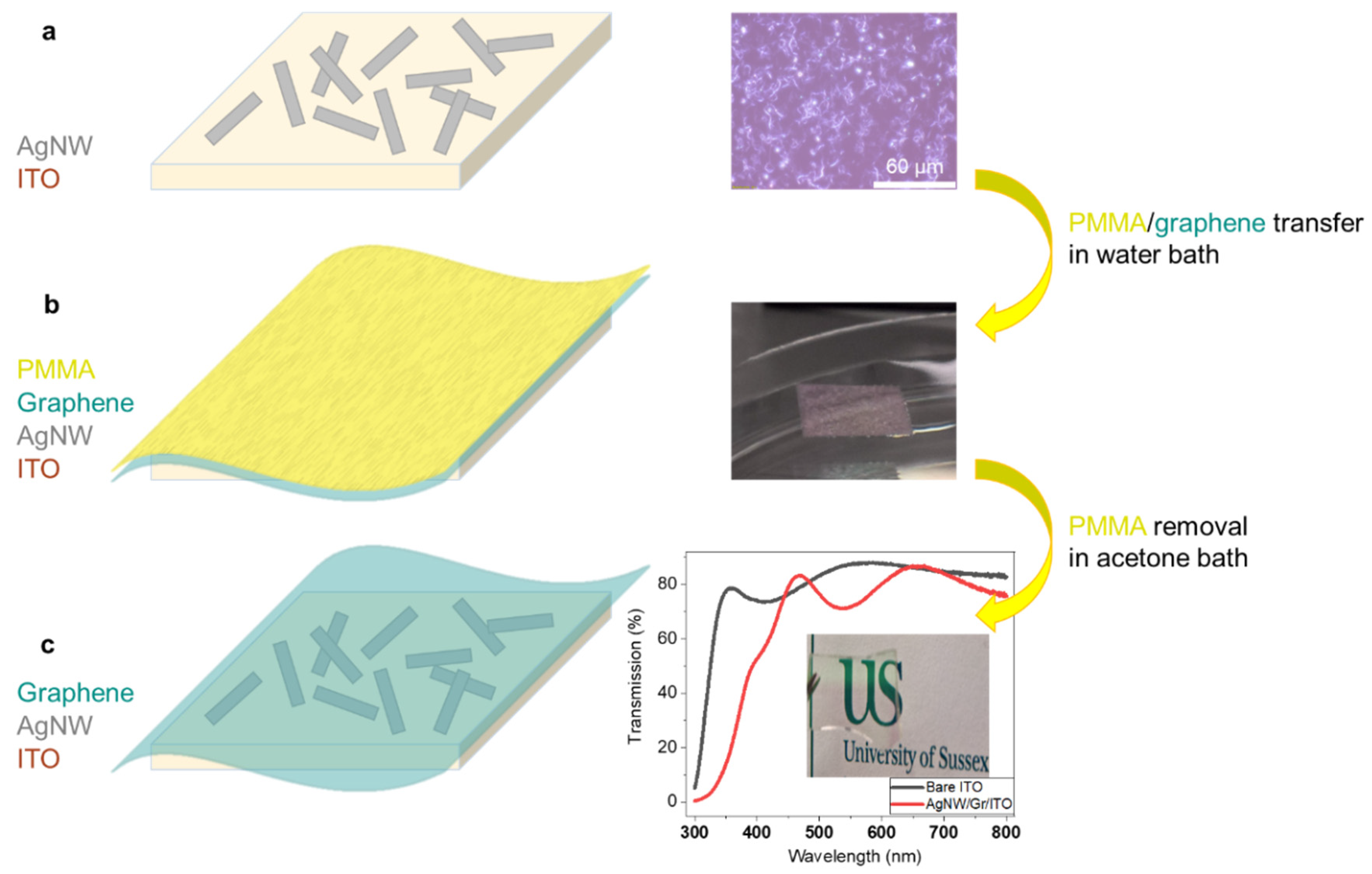
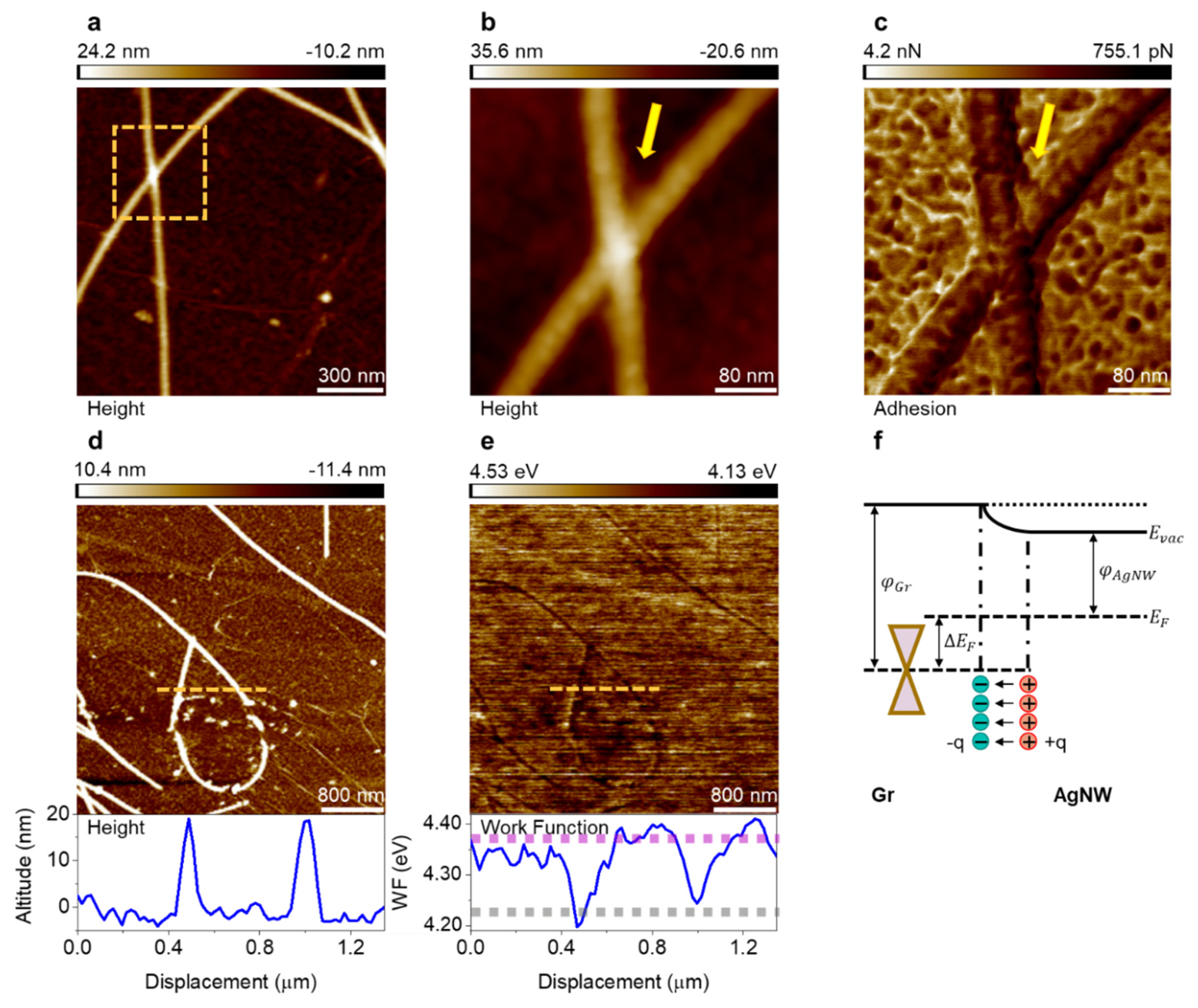
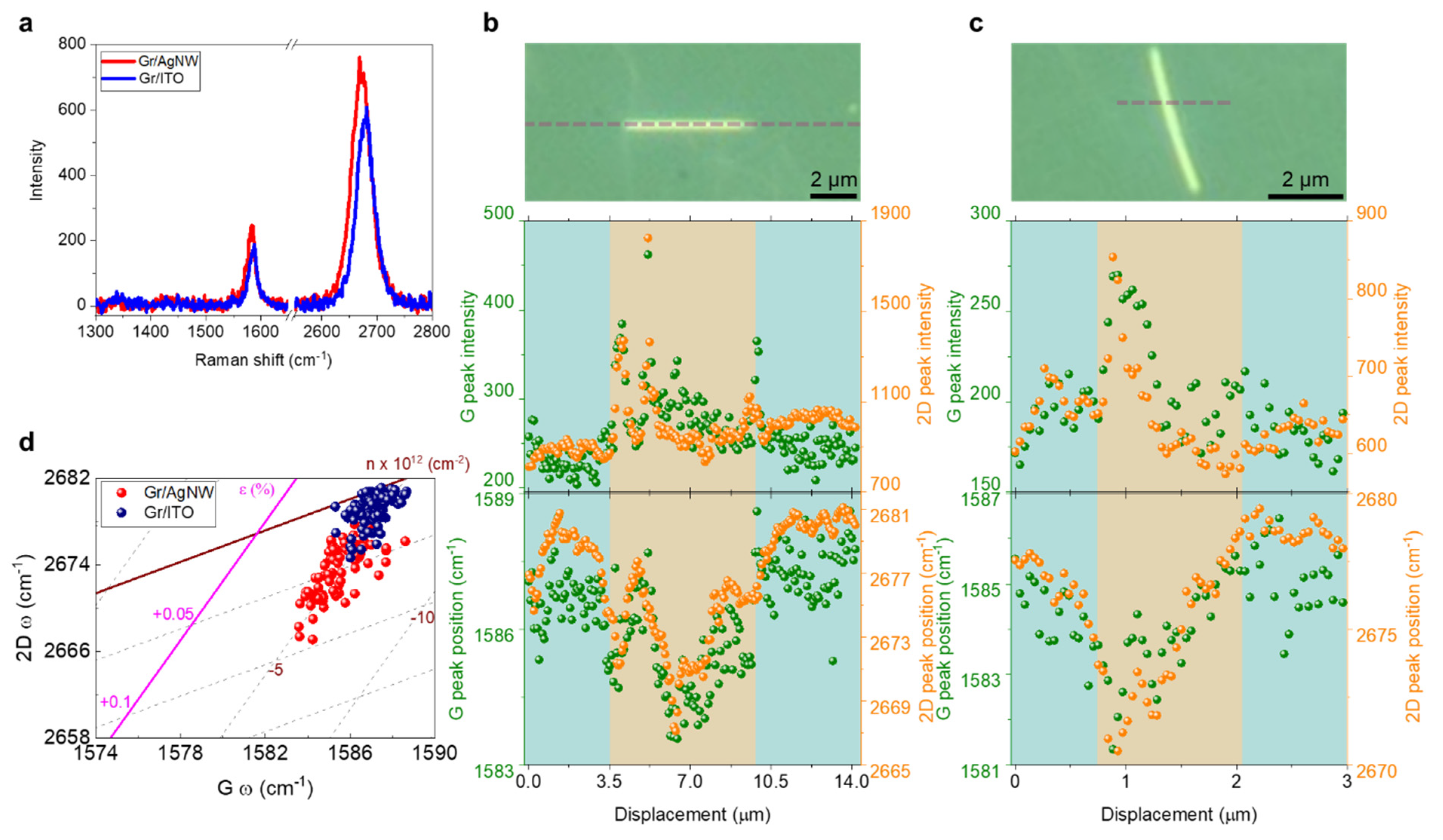
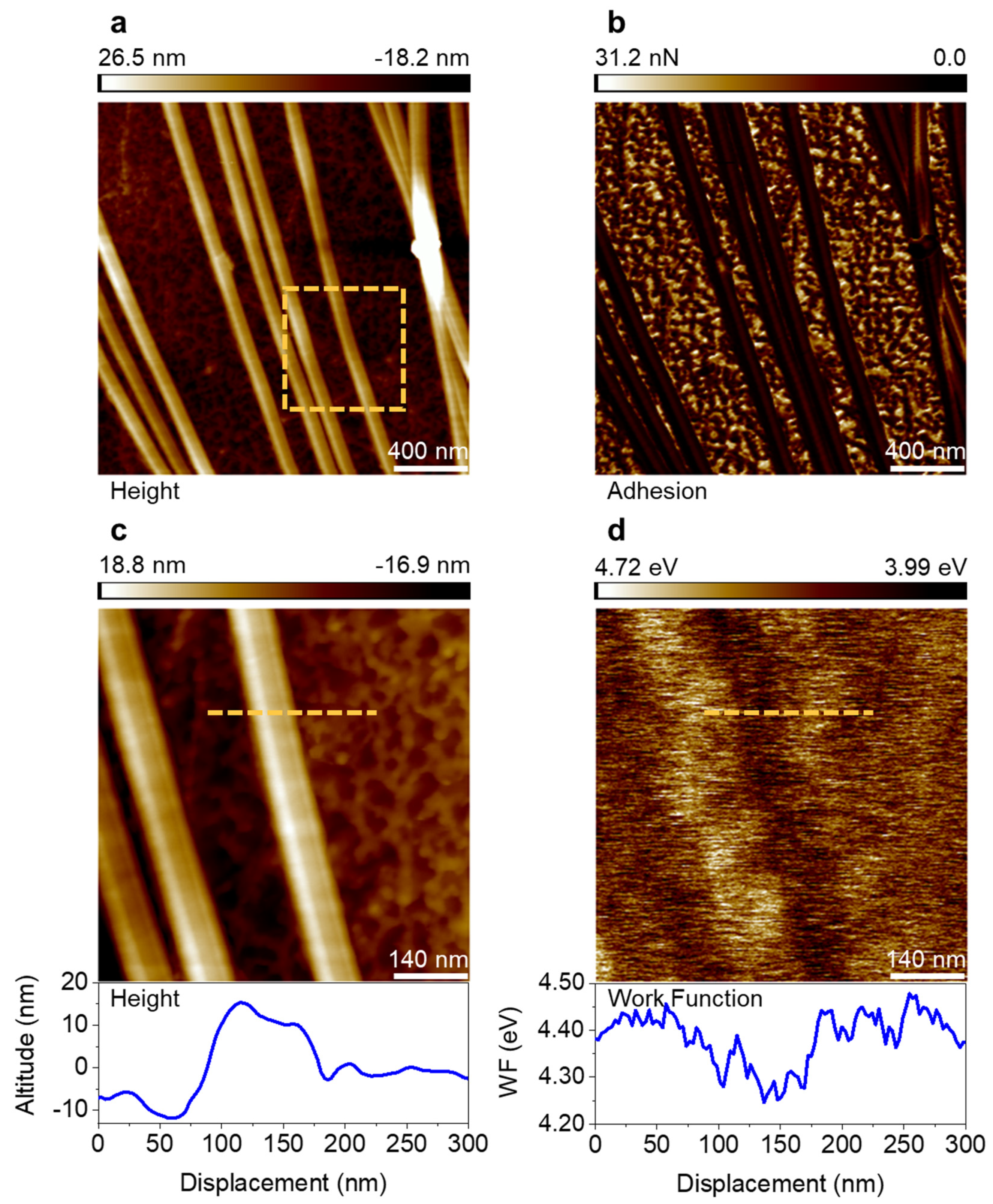
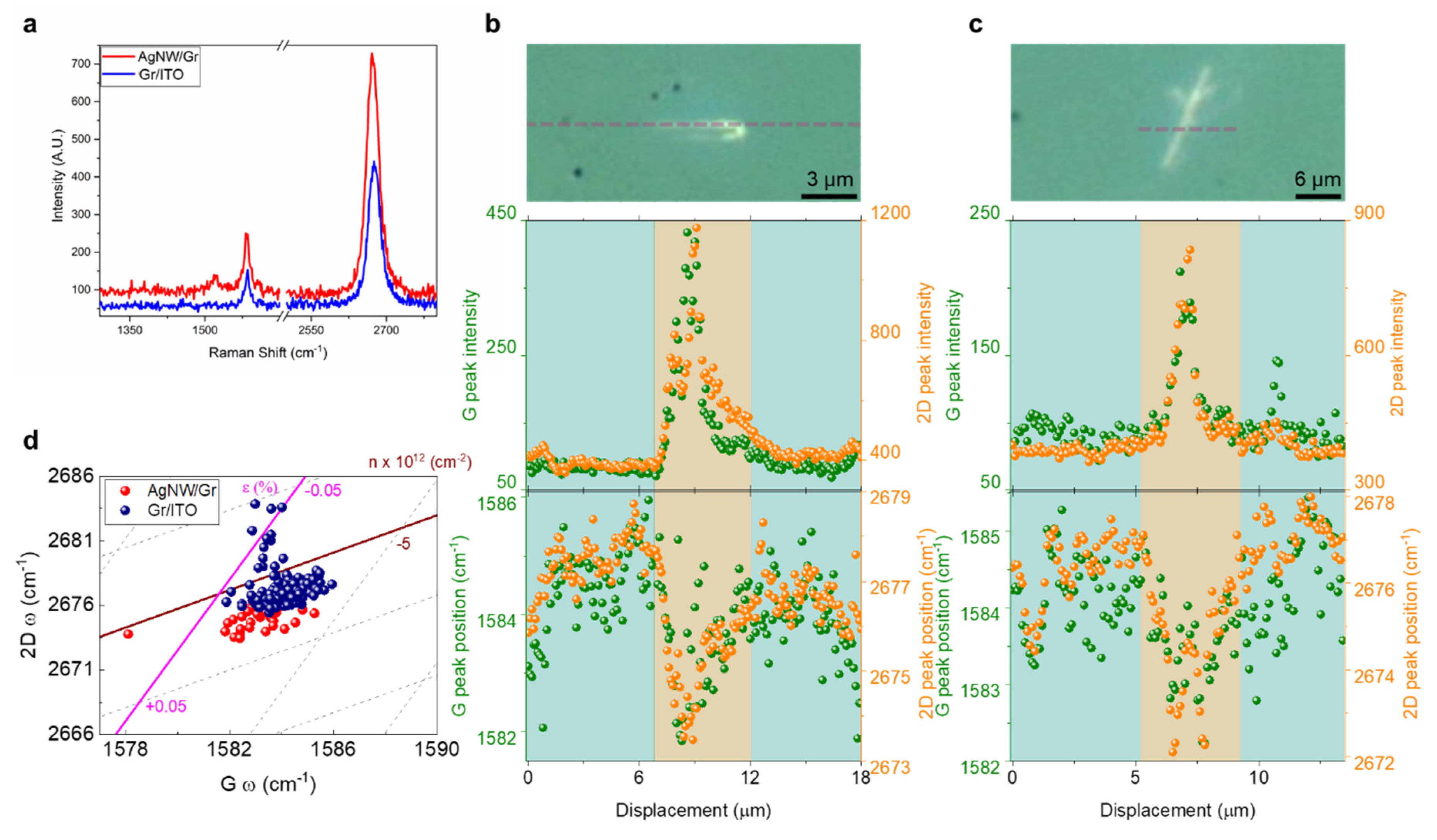
© 2020 by the authors. Licensee MDPI, Basel, Switzerland. This article is an open access article distributed under the terms and conditions of the Creative Commons Attribution (CC BY) license (http://creativecommons.org/licenses/by/4.0/).
Share and Cite
Lee, F.; Tripathi, M.; Lynch, P.; Dalton, A.B. Configurational Effects on Strain and Doping at Graphene-Silver Nanowire Interfaces. Appl. Sci. 2020, 10, 5157. https://doi.org/10.3390/app10155157
Lee F, Tripathi M, Lynch P, Dalton AB. Configurational Effects on Strain and Doping at Graphene-Silver Nanowire Interfaces. Applied Sciences. 2020; 10(15):5157. https://doi.org/10.3390/app10155157
Chicago/Turabian StyleLee, Frank, Manoj Tripathi, Peter Lynch, and Alan B. Dalton. 2020. "Configurational Effects on Strain and Doping at Graphene-Silver Nanowire Interfaces" Applied Sciences 10, no. 15: 5157. https://doi.org/10.3390/app10155157
APA StyleLee, F., Tripathi, M., Lynch, P., & Dalton, A. B. (2020). Configurational Effects on Strain and Doping at Graphene-Silver Nanowire Interfaces. Applied Sciences, 10(15), 5157. https://doi.org/10.3390/app10155157





